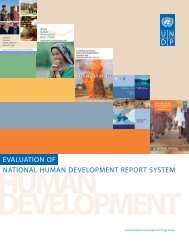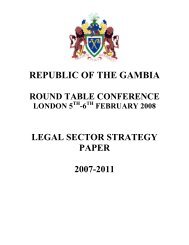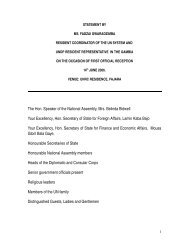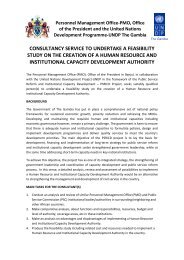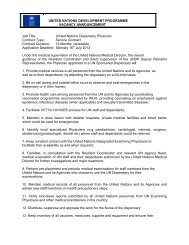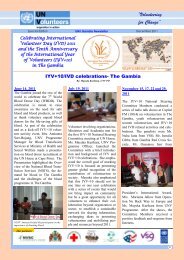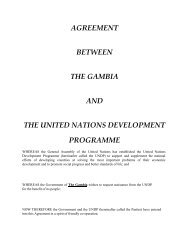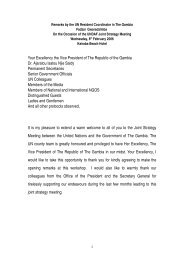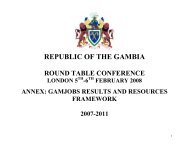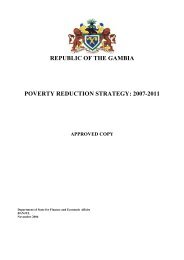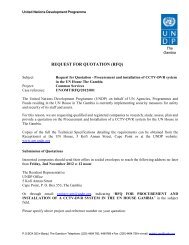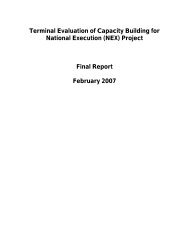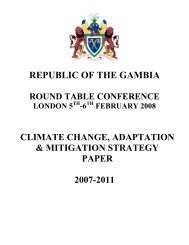Introduction - UNDP The Gambia
Introduction - UNDP The Gambia
Introduction - UNDP The Gambia
Create successful ePaper yourself
Turn your PDF publications into a flip-book with our unique Google optimized e-Paper software.
________________________________________________________________________________________________________________________<br />
<strong>The</strong> social hierarchy within these structures<br />
could be an impeding factor among the<br />
various castes in the communities. Among the<br />
Serahule, the caste system is very strong, and<br />
lack of understanding of this fact could affect<br />
any development initiative that require social<br />
mobilisation.<br />
<strong>The</strong> politicisation of the traditional structures<br />
could affect the level of engagement of all the<br />
critical parties in the community. <strong>The</strong>re are<br />
instances where individuals are removed from<br />
the structure because of their partisan political<br />
affiliation. This could affect the effectiveness<br />
of the structure.<br />
Lack of a clear sense of direction can derail<br />
the development target, hence the need to<br />
enhance the capacity of these structures to<br />
respond to the new roles and responsibilities<br />
they will be required to assume.<br />
5.3.1 Policy Context<br />
<strong>The</strong> <strong>Gambia</strong> is committed to the policy of<br />
decentralisation and it has undertaken several<br />
steps to put its policy in line with this process.<br />
However, formal commitment to<br />
decentralisation is yet to be translated into<br />
substantive commitment.<br />
Currently, all the measures needed to<br />
empower the communities are nonexistent.<br />
<strong>The</strong> infrastructure, resources and<br />
traditional structures needed to achieve<br />
commitment to the decentralisation process<br />
are lacking. Incentives to motivate people to<br />
remain in the rural areas have to be in place.<br />
For sustainable development to take place,<br />
the rural communities must play a crucial role<br />
in the process.<br />
<strong>The</strong> current centralised approach of the<br />
government will not adequately address the<br />
problems. Capacity will always be elusive if<br />
it does not commit itself to empower the nonstate<br />
actors to be effectively part of the<br />
development process. <strong>The</strong>refore, this<br />
approach may not achieve the fulfilment of<br />
the targets it has set for itself.<br />
5.3.2 Institutional Frameworks<br />
<strong>The</strong> <strong>Gambia</strong> is divided into seven<br />
administrative divisions, which are well<br />
established. <strong>The</strong>se administrative divisions<br />
have historically been the frame of reference<br />
for colonial development. <strong>The</strong>y are well<br />
defined with local government structures.<br />
However, these institutions are poorly<br />
resourced, and their budgets are very<br />
low. Rates collected do not address all the<br />
issues of the communities and where such<br />
rates are available they are sometimes<br />
insufficient to cover the expenditures of such<br />
divisions.<br />
<strong>The</strong> government needs to provide sufficient<br />
budget allocation to build capacity at this<br />
level. Also the existence of Divisional<br />
Development Committees vis-à-vis the<br />
multidisciplinary facilitation teams can be<br />
effective in providing technical support in the<br />
rural communities. <strong>The</strong>se structures need to<br />
be strengthened to respond to the demands.<br />
<strong>The</strong>y can be channels to develop the skills of<br />
the rural people.<br />
5.3.3 Gender and Local Structures<br />
While the local structures have been the point<br />
of reference for many development agents,<br />
they have not been able to address all the<br />
development concerns of the people. <strong>The</strong><br />
existing structures in <strong>The</strong> <strong>Gambia</strong> have<br />
always been known to be patrimonial and<br />
gender blind. In all the existing structures,<br />
women and men have unequal power<br />
relations in terms of decision-making, which,<br />
as a result, affects the outcomes of projects on<br />
the different genders.<br />
Involving these structures in the context of<br />
the country’s current development initiatives<br />
would require making use of gender analysis<br />
and analytical frameworks that would address<br />
the gender imbalances that are entrenched and<br />
taken for granted at all levels. Taking account<br />
of gender equality in the process is crucial to<br />
the attainment of sustainable development.<br />
________________________________________________________________________________________________<br />
Building Capacity for the Attainment of the Millennium Development Goals in <strong>The</strong> <strong>Gambia</strong> National Human Development Report 2005<br />
60




